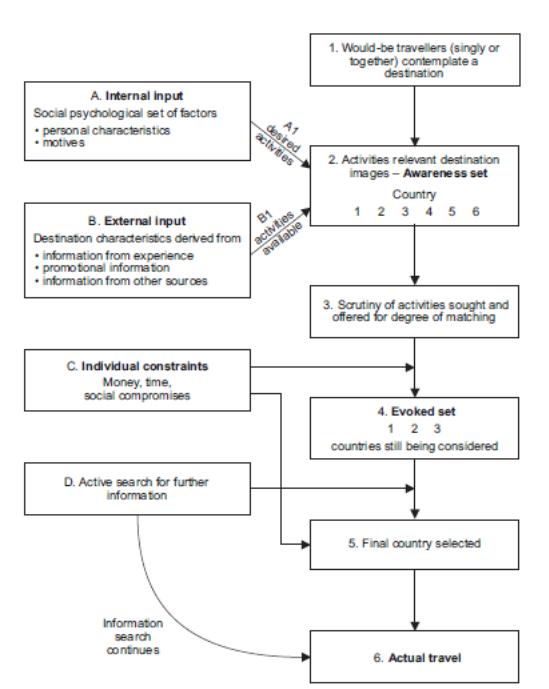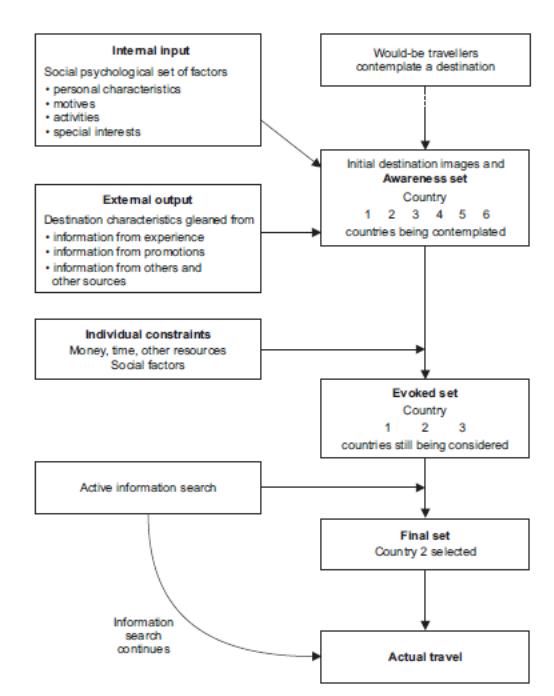
- •Tourism DestinationS Management
- •Kyiv 2014
- •Content
- •Introduction
- •Topic 1. Theoretical bases of tourism destinations formation and development Lecture Plan
- •Polarized growth in tourism
- •Tourism Destination concept Evolution of the definition “Tourist/Tourism Destination”
- •The modern model of Tourist Destintion
- •Classification of leisure destinations based on their principal attractions
- •Development conditions and factors of destination
- •Theories of tourism destination development
- •Classical Change Theory - The Life-Cycle Model
- •The Theory of Species Evolution
- •Punctuated Equilibrium model
- •Chaos Theory
- •Topic 2. Methodology of Tourist Destinations Management Research Lecture Plan
- •Objectives and research directions for tourism destinations
- •Scanning macro environment
- •Examples of macro-environment changes
- •Evaluating existing and potential tourism resources
- •Examples of Intangible resources
- •3. Assessing market trends and performance
- •4. Analysing competitiveness
- •Scale rating competition (Blank)
- •Methods of tourism destination studies
- •Innovation
- •Impact on local mobility
- •Phase 1 the diagnostic process
- •Topic 3. Tourism Destination Competitiveness Lecture Plan
- •The concept of tourism destination competitiveness Evolution of views on tourism destination competitiveness
- •Value chain of tourist destinations
- •Models of tourism destination competitiveness
- •Model of Destination Competitiveness and Sustainability (Ritchie and Crouch, 1993, 2000)
- •Travel & Tourism Competitiveness Index based on an initiative of the World Travel and Tourism Council (wttc)
- •Topic 4. Management of tourism destinations visitors’ consumer behavior Lecture plan
- •Consumer behavior of tourism destinations visitors. Behavior at different stages of the purchase and consumption
- •The main features of tourist behavior
- •Concept map for understanding tourist behaviour
- •I. The formation of touristic needs. Motivation
- •Decisions involved in choosing a destination
- •Factors influencing the destination decision
- •III. Tourists’ On-Site Experiences
- •IV. The customer satisfaction/dissatisfaction
- •The formation of loyalty to tourist destination
- •Motive factors and items
- •Trends in tourist`s consumer behavior Trends in travel motivation
- •Technological Changes in tourist`s consumer behavior
- •Modern tourist values
- •Specific models of market segmentation in tourism Types of tourists/travellers
- •Thirteen major emerging markets and changes in demand
- •Topic 5. Tourist Destinations planning Lecture Plan
- •Destination as an object of management
- •Strategic management objectives for destinations
- •Relationships between stakeholders in tourism
- •Public-private partnership in tourism destination management
- •Success factors in managing public-private partnerships in the tourist sector (unwto)
- •Destination management organizations (dmo), their levels
- •Destination Management Organisations levels
- •Topic 6. Tourist Destinations Marketing Lecture plan
- •The modern concept of tourism destination marketing
- •Marketing mix of tourism destination
- •Four destination product components
- •Applied areas of marketing research for the benefit of tourism destination Contribution of marketing research to destination marketing
- •Tourist destination Image and Brand Evolution of tourist destination image definition
- •Components of destination image and sample research procedures
- •Destination brand
- •Destination brand – Key points:
- •The difference between a destination product and a destination brand
- •Destination branding
- •Developing a branding strategy Branding Process
- •Brand Pyramid
- •Brand Wheel
- •Key challenges in developing and effectively applying a destination brand
- •Bringing the Brand to Life
- •Tourism destination Event marketing
- •Attraction
- •Image and Branding
- •Community
- •5.Tourism destination Internet Marketing Overview of the different e-marketing techniques at each stage of the ‘customer journey’
- •10 Key areas for action in e-marketing
- •1. Reach as many potential customers as possible
- •2. Maximise the lifetime value of customers, by maintaining the relationship via crm
- •3. Join the social networking revolution, facilitating user-generated content
- •4. Maintain high quality content
- •5. Create a compelling website experience
- •10. Ensure effective electronic distribution of information to visitors ‘en route’ and in the destination
- •Supporting technologies required to implement the ‘10 keys’
- •Organizational aspects of the tourism destinations marketing
- •Strategic marketing planning for tourist destination The key processes in determining a destination marketing plan are as follows:
- •Destination marketing planning process
- •Structure of the strategic marketing plan for Greece
- •Topic 7. Tourism Destinations in the context of the Sustainable Development Lecture plan
- •Environmental
- •12 Aims for sustainable tourism/ sustainable tourism development (unwto/unep)
- •The challenges of tourism destinations sustainable development
- •The general procedure that is commonly recommended for implementing sustainable tourism or sustainable development within a destination
- •Implement remedial actions where necessary • May require reassessment of st goals
- •Sustainable tourism strategy
- •Control of sustainable tourism Sustainable tourism indicators
- •Core wto Indicators of sustainable tourism (short list)
- •Bibliography
IV. The customer satisfaction/dissatisfaction

Two main approaches to defining satisfaction






The formation of loyalty to tourist destination








|
|
|
|
|
|
|
|
Current models of consumer behavior in tourism
A model of the destination choice process
|
|
|
|
|
|


|
|
|
|
|
|
Visitor’s behavior influencing factors
‘Pull’ factors are the destination attributes that fulfil visitors’ travel motives.
‘Push’ factors are forces arising from the individual and from the individual’s social context. These are real motivational forces and determine destination’s ‘competitiveness’ from the tourist’s viewpoint
Factors which influence the tourist to purchase a particular tourism product
factors
which motivate the tourist to wish to purchase a particular product
___________ ________________________________________________________________________________________________________________________________________________

factors
which determine to what extent tourists are able to purchase the
product they desire_______________________________ ________________________________________________________________________________________________________________________________________________


|
|
|
|
Motive factors and items
Factors
|
Motive items
|
Novelty |
having fun |
experiencing something different |
|
feeling the special atmosphere of the vacation destination |
|
visiting places related to my personal interests |
|
Escape/relax |
resting and relaxing |
getting away from everyday psychological stress/pressure |
|
being away from daily routine |
|
getting away from the usual demands of life |
|
giving my mind a rest
|
|
not worrying about time |
|
getting away from everyday physical stress/pressure |
|
Relationship (strengthen) |
doing things with my companion(s) |
doing something with my family/friend(s) |
|
being with others who enjoy the same things as I do |
|
strengthening relationships with my companion(s) |
|
strengthening relationships with my family/friend(s) |
|
contacting with family/friend(s) who live elsewhere |
|
Autonomy |
being independent |
being obligated to no one |
|
doing things my own way |
|
Nature |
viewing the scenery |
being close to nature |
|
getting a better appreciation of nature |
|
being harmonious with nature |
|
Stimulation |
exploring the unknown |
feeling excitement |
|
having unpredictable experiences |
|
being spontaneous |
|
having daring/adventuresome experience |
|
experiencing thrills |
|
experiencing the risk involved |
|
Self- development (personal development) |
develop my personal interests |
knowing what I am capable of |
|
gaining a sense of accomplishment |
|
gaining a sense of self-confidence |
|
developing my skills and abilities |
|
using my skills and talents |
Relationship (security)
|
feeling personally safe and secure |
being with respectful people |
|
meeting people with similar values/interests |
|
being near considerate people |
|
being with others if I need them |
|
feeling that I belong |
|
Self- actualise
|
gaining a new perspective on life |
feeling inner harmony/peace |
|
understanding more about myself |
|
being creative |
|
working on my personal/spiritual values |
|
Isolation
|
experiencing the peace and calm |
avoiding interpersonal stress and pressure |
|
experiencing the open space |
|
being away from the crowds of people |
|
enjoying isolation |
|
Nostalgia |
thinking about good times I've had in the past |
reflecting on past memories |
|
Romance |
having romantic relationships |
being with people of the opposite sex |
|
Recognition |
sharing skill and knowledge with others |
showing others I can do it |
|
being recognised by other people |
|
leading others |
|
having others know that I have been there |
Determinants include the set of factors defining:
• the destination for the trip
• when the trip will be taken
• the mode of travel to be used
• the duration of the trip
• who will comprise the holiday party or group
• the type of accommodation that will be used
• the activities undertaken by the tourist during the holiday
• how much will be spent on the trip.
|
|
|
|
|
|


